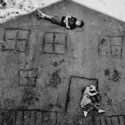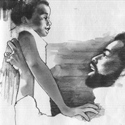 The Brewster Projects are where Diana Ross, Mary Wilson, and Smokey Robinson grew up. They were the first federally funded public housing development for African Americans, remnants of a time when black citizens faced restrictive covenants in land deeds that prevented them from moving into white neighborhoods. The projects were built when the development of I-75 displaced residents of the black neighborhood of Paradise Valley. Last year at this time, people were still living in several of the towers until the housing commission shut operations down for good. By June 2008, the only people living in the towers were squatters and scrappers diligently removing all recyclable metals from the four towers and numerous low-rises. All summer you could hear the terrible sound of refrigerators falling 14 stories and crashing on the concrete below. Scrappers meticulously removed every aluminum window pane, sending down cascades of glass. Different groups of scrappers claimed territory throughout the projects. It was like the Wild West. There's copper in them buildings.
The Brewster Projects are where Diana Ross, Mary Wilson, and Smokey Robinson grew up. They were the first federally funded public housing development for African Americans, remnants of a time when black citizens faced restrictive covenants in land deeds that prevented them from moving into white neighborhoods. The projects were built when the development of I-75 displaced residents of the black neighborhood of Paradise Valley. Last year at this time, people were still living in several of the towers until the housing commission shut operations down for good. By June 2008, the only people living in the towers were squatters and scrappers diligently removing all recyclable metals from the four towers and numerous low-rises. All summer you could hear the terrible sound of refrigerators falling 14 stories and crashing on the concrete below. Scrappers meticulously removed every aluminum window pane, sending down cascades of glass. Different groups of scrappers claimed territory throughout the projects. It was like the Wild West. There's copper in them buildings.
Not long ago, a Dutch journalist and her photographer were carjacked while reporting from what remains of the Brewster Projects. That hasn't been an issue for me. I walk there. This is a high-rise kitchen half deconstructed by scrappers. They'll be back.
This is a high-rise kitchen half deconstructed by scrappers. They'll be back. I quickly became interested in what was left behind in the hundreds of walk-in closets throughout these projects. This one smelled like it had been occupied very recently. I can only assume the stolen gas tanks were just there
I quickly became interested in what was left behind in the hundreds of walk-in closets throughout these projects. This one smelled like it had been occupied very recently. I can only assume the stolen gas tanks were just there as a way to get high as fuel for portable heaters and that the pack-n-play was there for a sleeping baby. Some of the furniture looks like it has been there since the 1950s, when the high-rises were built. Some of the occupants may have spent most of their lives in these rooms. Of course this leads to the question: where did they all go?
Some of the furniture looks like it has been there since the 1950s, when the high-rises were built. Some of the occupants may have spent most of their lives in these rooms. Of course this leads to the question: where did they all go? There are abandoned photographs in many rooms, small hints of the human beings who used to live in these dead buildings.
There are abandoned photographs in many rooms, small hints of the human beings who used to live in these dead buildings.
 There are quite a few fake houseplants and fake flowers, deceptions of lingering life.
There are quite a few fake houseplants and fake flowers, deceptions of lingering life. This was once a display board at the funeral for a beautiful baby boy. It had several photographs of him playing, smiling. Surrounding the typed words, "Family," "Home," and "Love," were departing messages from those who attended his funeral. "One Love---Your Big Brother, G Mack". . . "Little man, I will miss u." It lay trampled on the same floor where the baby might once have played, or taken his first steps. In the rush of eviction, it was left behind.
This was once a display board at the funeral for a beautiful baby boy. It had several photographs of him playing, smiling. Surrounding the typed words, "Family," "Home," and "Love," were departing messages from those who attended his funeral. "One Love---Your Big Brother, G Mack". . . "Little man, I will miss u." It lay trampled on the same floor where the baby might once have played, or taken his first steps. In the rush of eviction, it was left behind. Some of the closets were full of things, but I was most interested in those where only a few items remained. Like a hanger, a bible, and a bottle of cologne.
Some of the closets were full of things, but I was most interested in those where only a few items remained. Like a hanger, a bible, and a bottle of cologne. A 1960s suit jacket, still on the haberdasher's hanger.
A 1960s suit jacket, still on the haberdasher's hanger. A cane, a fanny pack, and a cheap, blue faux-fur stole.
A cane, a fanny pack, and a cheap, blue faux-fur stole. A creepy Styrofoam head with a church hat and part of a weave.
A creepy Styrofoam head with a church hat and part of a weave. In one apartment I found an elderly woman's record book, and on pages where she wasn't keeping track of bills or crafting long lists of lottery numbers, she was keeping track of her love life. This page reads, "I am going to buy our ring and ask him to marry me. I know he going to say yes. We are going to get marry in Sep. We will go over to Ohio and get marry. And later have a big dinner to let people know we are marry." On other pages she writes out her first name with his last name over and over like a schoolgirl. I won't say how it ends.
In one apartment I found an elderly woman's record book, and on pages where she wasn't keeping track of bills or crafting long lists of lottery numbers, she was keeping track of her love life. This page reads, "I am going to buy our ring and ask him to marry me. I know he going to say yes. We are going to get marry in Sep. We will go over to Ohio and get marry. And later have a big dinner to let people know we are marry." On other pages she writes out her first name with his last name over and over like a schoolgirl. I won't say how it ends. This was her bedroom.
This was her bedroom. This was one of the offices where files were maintained. To live in these projects you had to have a job but you couldn't earn too much. And you had to prove it with paystubs, tax forms. Living with relatives who committed crimes could subject residents to eviction. The housing authority kept detailed records about everything and just left these private files and reports in the buildings when they were abandoned.
This was one of the offices where files were maintained. To live in these projects you had to have a job but you couldn't earn too much. And you had to prove it with paystubs, tax forms. Living with relatives who committed crimes could subject residents to eviction. The housing authority kept detailed records about everything and just left these private files and reports in the buildings when they were abandoned.
* * * *
I talk about some of these things, and more, in an interview with Dick Gordon on today's edition of The Story (one of our favorite programs on public radio). I'm afraid it makes me out to be much more of an urban explorer than I actually am (there are many, many people who do this stuff far more and far better than I do). I just have a bully pulpit. That said, I did get to spend part of yesterday driving around and exploring Detroit's ruins with Camilo Jose Vergara. That's sort of like a foodie getting to hang out with Anthony Bourdain or a trekkie hanging out with William Shatner. In other words, it was awesome.
If you're visiting for the first time after hearing me on the radio, welcome. On this website I write about far more than just buildings and the city where I live. But you can read some of the things I've written about Detroit here.
The story about the building with all the books on the floor is here and here.
The story of Detroit's abandoned Belle Isle Zoo is here.
The photos of Detroit schools that appeared in Vice Magazine are here (this post describes more recent adventures in schools).
And if you're looking for hope, you might find some here.
Copyright © 2005-2016 Sweet Juniper Media, Inc.
All Rights Reserved.
All Rights Reserved.
"Sweet Juniper" is a registered trademark.
No unauthorized reuse.
No unauthorized reuse.
Categories
- Friday Morning Street Urchin Blogging ( 107 )
- Detroit ( 60 )
- SAHD ( 34 )
- photography ( 30 )
- Thursday Morning Wood ( 25 )
- Halloween ( 23 )
- Thrift ( 18 )
- abandoned places ( 18 )
- terrifying nixon-era children's books ( 16 )
- Reminiscin' ( 15 )
- Sweet Juniper Media ( 11 )
- Wendell ( 10 )
- Design ( 9 )
- San Francisco ( 9 )
- nature fights back ( 9 )
- sleep ( 9 )
- if you ain't dutch you ain't much ( 8 )
- sentimental ( 7 )
- Music ( 6 )
- Parody ( 6 )
- birth story ( 6 )
- scrappers ( 6 )
- Sweet Juniper Tunes ( 5 )
- lawyering ( 5 )
- Zoo ( 4 )
- elegant leisure ( 4 )
- language ( 3 )
- feral houses ( 2 )
- theme parks of the damned ( 2 )
- zombies ( 1 )
Archives
- November 2017 ( 2 )
- December 2016 ( 1 )
- November 2016 ( 2 )
- December 2015 ( 1 )
- November 2015 ( 2 )
- December 2014 ( 1 )
- October 2014 ( 2 )
- April 2014 ( 1 )
- December 2013 ( 2 )
- November 2013 ( 1 )
- October 2013 ( 1 )
- September 2013 ( 2 )
- July 2013 ( 2 )
- June 2013 ( 1 )
- April 2013 ( 1 )
- March 2013 ( 3 )
- February 2013 ( 1 )
- January 2013 ( 1 )
- December 2012 ( 2 )
- November 2012 ( 1 )
- October 2012 ( 4 )
- September 2012 ( 2 )
- August 2012 ( 2 )
- July 2012 ( 1 )
- June 2012 ( 3 )
- May 2012 ( 1 )
- April 2012 ( 2 )
- March 2012 ( 1 )
- February 2012 ( 2 )
- January 2012 ( 1 )
- December 2011 ( 3 )
- November 2011 ( 3 )
- October 2011 ( 5 )
- September 2011 ( 3 )
- August 2011 ( 4 )
- July 2011 ( 4 )
- June 2011 ( 2 )
- May 2011 ( 4 )
- April 2011 ( 6 )
- March 2011 ( 7 )
- February 2011 ( 4 )
- January 2011 ( 4 )
- December 2010 ( 5 )
- November 2010 ( 7 )
- October 2010 ( 5 )
- September 2010 ( 4 )
- August 2010 ( 5 )
- July 2010 ( 7 )
- June 2010 ( 5 )
- May 2010 ( 5 )
- April 2010 ( 5 )
- March 2010 ( 4 )
- February 2010 ( 5 )
- January 2010 ( 5 )
- December 2009 ( 6 )
- November 2009 ( 5 )
- October 2009 ( 8 )
- September 2009 ( 9 )
- August 2009 ( 6 )
- July 2009 ( 9 )
- June 2009 ( 8 )
- May 2009 ( 8 )
- April 2009 ( 8 )
- March 2009 ( 12 )
- February 2009 ( 11 )
- January 2009 ( 9 )
- December 2008 ( 11 )
- November 2008 ( 9 )
- October 2008 ( 14 )
- September 2008 ( 11 )
- August 2008 ( 11 )
- July 2008 ( 12 )
- June 2008 ( 10 )
- May 2008 ( 9 )
- April 2008 ( 8 )
- March 2008 ( 10 )
- February 2008 ( 15 )
- January 2008 ( 12 )
- December 2007 ( 9 )
- November 2007 ( 12 )
- October 2007 ( 11 )
- September 2007 ( 13 )
- August 2007 ( 11 )
- July 2007 ( 8 )
- June 2007 ( 12 )
- May 2007 ( 10 )
- April 2007 ( 10 )
- March 2007 ( 12 )
- February 2007 ( 14 )
- January 2007 ( 12 )
- December 2006 ( 11 )
- November 2006 ( 10 )
- October 2006 ( 13 )
- September 2006 ( 8 )
- August 2006 ( 13 )
- July 2006 ( 13 )
- June 2006 ( 15 )
- May 2006 ( 13 )
- April 2006 ( 9 )
- March 2006 ( 10 )
- February 2006 ( 3 )
- January 2006 ( 5 )
- December 2005 ( 2 )
- November 2005 ( 8 )
- October 2005 ( 4 )
- September 2005 ( 1 )
- July 2005 ( 3 )


























